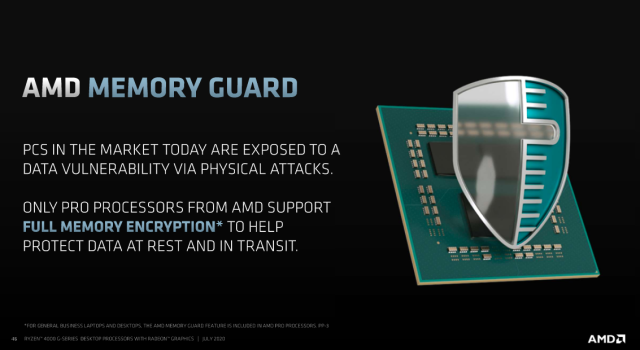This morning, AMD announced the next big thing for its Ryzen desktop CPU line—the Ryzen 4000 series, slated to arrive in Q3 2020.
Those of you who have been waiting breathlessly for Zen 3 architecture will need to keep waiting—Ryzen 4000 desktop CPUs are still built on 7nm, Zen 2 architecture. There also don’t appear to be any performance recordbreakers in Ryzen 4000’s desktop lineup: the highest-end SKU announced is the 65W 8 core / 16 thread Ryzen 7 Pro 4750G.
Instead, AMD is taking solid aim at rival Intel’s chokehold on the office PC market. Every single one of the 18 new processor SKUs announced features integrated Radeon graphics—and nine of the 18 are “GE” suffix CPUs, meaning only 35W TDP. Both of these features are highly desirable in either home-office or business environments—Radeon integrated graphics are good enough for anything short of high-end content creation or gaming, and lower TDP means lower power bills and lower cooling bills as well in hotter climates.
Desktop Ryzen 4000 Architecture and performance
The new Ryzen 4000 G-series APUs will continue to use the AM4 socket and are based on 7nm Zen2 architecture just like the earlier Ryzen 3000 CPUs. They’re essentially Ryzen Mobile 4000 APUs writ large, upscaled into desktop-class frequency, power, and thermal budgets.
In at least one way, the new series is a step backward from Ryzen 3000: the 4000 G-series only offers PCI express 3.0, not 4.0. Each chip offers eight PCIe 3.0 lanes for expansion cards—we don’t know yet whether there will be additional PCIe lanes for NVMe devices. This isn’t likely to be a problem for Ryzen 4000 G-series customers—these CPUs are all designed to be used with integrated graphics, and none of them outperforms the higher-end Ryzen 3000 desktop CPUs in the first place.
When it comes to estimating what 4000 G-series’ performance will look like, AMD offered us much less concrete data than we’ve become accustomed to. The company wasn’t shy about telling us that G series is faster than competing Intel vPro CPUs, and by how much—but AMD is remarkably cagey about comparisons to earlier Ryzen CPUs. Slides claim “over 2.5x more performance than last gen”—but those numbers are obtained by comparing Ryzen 7 4700G to Ryzen 5 3450G, not to Ryzen 7 3700X.
If we want to get a realistic comparison to Ryzen 3000 desktop CPUs, we’re left to do a little donkey work and hope the numbers line up. AMD’s slide claims “+152%” Cinebench R20 multi-threaded results when comparing Ryzen 7 4700G to Ryzen 5 3450G—this isn’t very useful by itself, but it gives us something to go on.
CGIdirector shows Ryzen 5 3450G attaining an R20 multi-threaded score of 1,995. If we add 152 percent to that, we come up with a score of 5,027. This guesstimated raw score comes out to a measly 3.5 percent improvement over Ryzen 7 3700X—and a dead heat with Ryzen 7 3800X.
Running the numbers this way might be a bit sloppy—but it seems to thoroughly answer the question “Why is AMD comparing Ryzen 7 4000 to Ryzen 5 3000?”
Ryzen 4000 APU models


Eighteen different SKUs were announced today—but there are really only five new base models. Four of them have both G and GE (power efficient) models, and all of them have both Pro and non-Pro models—the difference being that Pro models explicitly support AMD Memory Guard and AMD Secure Processor technologies, and non-Pro models do not.
| Base Model | Cores/Threads | TDP (G model) | TDP (GE model) | Boost/Base Frequency (G model) | Boost/Base Frequency (GE model) | L2+L3 cache |
| Ryzen 7 4700 / 4700 Pro | 8C / 16T | 65W | 35W | Up to 4.4GHz / 3.6GHz | Up to 4.3GHz / 3.1GHz | 12MiB |
| Ryzen 5 4600 / 4600 Pro | 6C / 12T | 65W | 35W | Up to 4.2GHz / 3.7GHz | Up to 4.2GHz / 3.3GHz | 11MiB |
| Ryzen 3 4300 / 4300 Pro | 4C / 8T | 65W | 35W | Up to 4.0GHz / 3.8GHz | Up to 4.0GHz / 3.5GHz | 6MiB |
| Athlon Gold 3150 / 3150 Pro | 4C / 4T | 65W | 35W | 3.9GHz | 3.8GHz | 6MiB |
| Athlon Silver 3050 / 3050 Pro | 2C / 4T | n/a | 35W | n/a | 3.4GHz | 5MiB |
Availability
If you’re dreaming of building your own inexpensive-but-awesome Ryzen 4000 system with integrated Radeon graphics, we’ve got bad news for you—this entire series of processors will be available to OEMs and System Integrators (read: OEMs, but a little smaller than Lenovo or HP) only. The Pro versions of these Ryzen 4000 desktop APUs are available to OEMs and SIs today, and systems featuring both Pro and non-Pro Ryzen 4000 APUs are expected to be available from larger OEMs in the fall.
